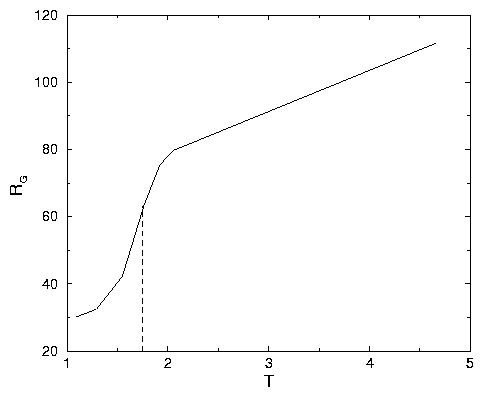
The behavior of a polymer in the solvent is very important in biology and chemistry. All important biological molecules such as DNA, RNA, Proteins and Lipids are polymers which contain many small similar monomers: nucleotides in case of DNA and RNA, aminoacids in case of proteins and hydrocarbons in case of lipids. The polymers in the cell are surrounded by water which contains different ions and other small molecules. The monomers of the polymer can be hydrophobic or hydrophilic, they attract to water or repulse from them. Very small changes in temperature or quality of solvent can produce dramatic effects on the shape and size of the biological proteins. For example the proteins can fold into compact native state at which they can function as a nanoscale robots. Thus it is very important to understand the behavior of the polymers in the solvent.
The movie polymer shows the behavior of the polymer chain with the temperature.
|
| Temperature | PotE | Radius of Gyration (Rg) |
| 1.0 | ||
| 1.1 | ||
| 1.2 | ||
| 1.3 | ||
| 1.4 | ||
| 1.5 | ||
| 1.6 | ||
| 1.7 | ||
| 1.8 | ||
| 1.9 | ||
| 2.0 | ||
| 2.1 | ||
| 2.2 | ||
| 2.3 | ||
| 2.4 | ||
| 2.5 |
1. Open Universal Application. Press on Play Movie and select Polymer.mov.
Press Forward. Watch the temperature graph until the time or frame
suggested below. You see a polymer formed by identical monomers of diameter
8 and attractive distance 11.28. The bonds between the monomers can fluctuate
in the range between 8 and 11.28. The energy of attraction between monomers
is -1. The polymer is collapsed and forms a dense globule, similar to the liquid
droplet. The temperature is T = 1.3 In this movie each frame corresponds to
10 units of time. At time 350 we instantaneously changes the temperature to
a very high value. The polymer start to swell. The behavior is similar to
the evaporation of the liquid. However the monomers of the polymer remain
linked with each other by chemical bonds. At time 1920 (frame 195) we again
cool down the polymer. It starts to collapse, but in a different way than
if we just watch the unfolding in reverse order. At first, monomers attract
to each other locally forming the so called secondary structures, i.e. little
sociges . These sociges attract to each other forming large blobs at the end
of the chain. Finally both blobs collapse into a single globule as compact
as before we raise the temperature. The shape of the polymer chain can be
characterized by its radius of gyration, which is the root mean square displacements
of the monomers from the center of gravity. Switch the graph to Average Radius
vs. time. You can see how the radius of gyration change upon the change of
temperature. Close Movie.
2. Open simulation: polymer.txt. Set the temperature for various values
from 1.0 to 2.5 at intervals of 0.1. For each temperature average for 50000
time units find the potential energy and radius of gyration and record the
values on the table. Make a graph of the potential energy and radius of gyration
as function of the temperature.
|
~ This point is called the q-point which is the analogous of a phase transition, from folded to unfolded,
for polymers. Close the simulation.
3. Open simulation: polymer32.txt, polymer64.txt, polymer128.txt and
polymer512.txt. Repeat Step [2.] for all these polymers of different lengths
(N). Find the behavior of the RG vs. N for T = 1.2, T = 2.5 and
T = q The Nobel laureate Paul Flory discovered that for T > 2.5 RG is
proportional to N0.6. At the q-point RG ~ ÖN and below the q-point RG ~ N1/3.
|
A2.27: This graph has a step at temperature 0.537. The value of this step is
the latent heat of crystallization which value is 1722. As the number of atoms
is 1000, the latent heat per atom is 1.722. See Fig .2.7.
A2.28: For T > 2.5 the slope is 0.6. Below the q-point it is 1/3, above 0.6 and 1/2 at the q-point.
